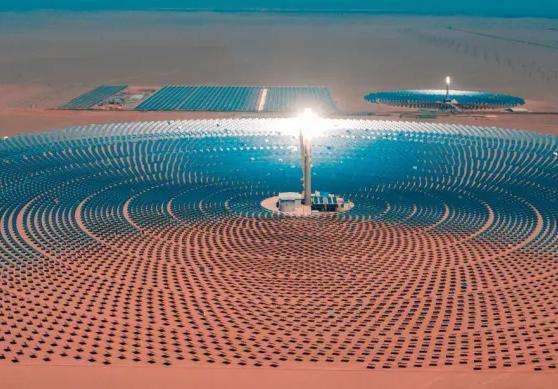Take an installed capacity of 1MW as an example (300KW is 0.3MW), you can convert it yourself.
The installed capacity of an electrical system refers to the sum of the nominal effective power of the generators actually installed in the system.
Since photovoltaic power generation must suffer losses, the actual electricity generation cannot reach the theoretical value.
1. Theoretical annual energy production of a 1 MW photovoltaic plant:
= Total average annual solar radiation*Total cell area*Photoelectric conversion efficiency
=5555.339* 6965 * 17.5%
=6771263.8MJ
=6771263.8*0.28 KWH
=1895953.86 KWH
=1.896 million degrees
2. Actual Power Generation Efficiency
The DC power produced by the solar panel is the rated power of the solar panel. Solar panels operating on thefield often do not meet the standard test conditions and the allowable output deviation is 5%. Therefore, the influence coefficient of 0.95 should be considered when analyzing the power output of solar panels.
As the temperature of the photovoltaic module increases, the output power of the f:l group will decrease. For crystalline silicon modules, when the temperature inside the photovoltaic module reaches 50-75°C, its output power drops to 89% of the rated value. When analyzing the power output of solar panels, the influence coefficient of 0.89 should be taken into account. .
The accumulation of dust on the surface of photovoltaic modules will affect the intensity of solar radiation radiated to the surface of the panel, and will also affect the output power of the solar panel. According to reports from relevant literature, this factor will have a 7% impact on production of photovoltaic modules, and the impact coefficient of 0.93 should be taken into account when analyzing the power output of solar panels.
Due to the inhomogeneity of solar radiation, it is almost impossible for the output power of photovoltaic modules to reach the maximum power at the same time, so the output power of the photovoltaic generator is less than the sum of the nominal powers of each module.
In addition, there is mismatch of photovoltaic modules and loss of panel connection, etc. The coefficient of these factors affecting the output power of solar panels is calculated to be 0.9.
The efficiency of the photovoltaic plant connected to the grid after taking into account the installation angle is 0.88.
The real efficiency of electricity production is therefore: 0.9 5 * 0.8 9 * 0.9 3*0.9 5 *0.8 8 = 65.7%.
3. The annual production ofActual system energy:
=Theoretical annual energy production*Actual energy production efficiency
=189.6*0.9 5 * 0.8 9 * 0.9 3* 0.9 5 * 0.8 8
=189.6*65.7%
=1.2456 million degrees
What is the difference between the installation of photovoltaic panels on the facade and the installation of the roof of the building?
There are several principles for determining line spacing:
There is no blocking between certain periods of the winter solstice, usually from 9:00 a.m. to 3:00 p.m.;
Based on local lighting resources, set appropriate spacing so that power generation can be within a certain range. Scope Maximize surface area.
To determine spacing, you must consider local latitude and local lighting resources. If you follow principle 1 and calculate with a latitude of 10 degrees, the spatial distance between rows is approximately 1 times the diheight difference.
The differences between the installation of photovoltaic panels on building facades and installations on the roof:
1. Horizontal roof light arrays can be installed at optimal angles to achieve a maximum amount of power generation, and conventional crystalline silicon photovoltaic modules can be used to reduce component investment costs and are relatively economically efficient. , but the aesthetics of this installation method are average.
2. Northern Hemisphere sloping roofs can be used to install photovoltaic panels on south, southeast, southwest, east or west facing roofs. On south-facing sloping roofs, photovoltaic panels can be installed in the best orientation. or Close to the optimal orientation for installation.
3. Photovoltaic lighting roofs frefer to building components that use transparent photovoltaic cells as lighting roofs. They are very beautiful and meet the needs of light transmission. However, photovoltaic lighting roofs require transparent components and the efficiency of the components is. weak. In addition to transparent power generation components, lighting roof components must meet certain architectural requirements such as mechanics, aesthetics and structural connection. The cost of components and power generation is high.
4. Side elevation installation mainly refers to the method of installing photovoltaic modules on the south, west and east walls of the building. For high-rise buildings, the wall is the exterior surface with the greatest contact. sunny area. On the surface, photovoltaic curtain walls are a relativelycurrent.














